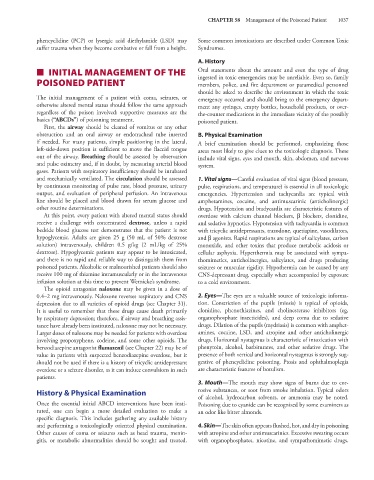Page 1051 - Basic _ Clinical Pharmacology ( PDFDrive )
P. 1051
CHAPTER 58 Management of the Poisoned Patient 1037
phencyclidine (PCP) or lysergic acid diethylamide (LSD) may Some common intoxications are described under Common Toxic
suffer trauma when they become combative or fall from a height. Syndromes.
A. History
■ INITIAL MANAGEMENT OF THE Oral statements about the amount and even the type of drug
ingested in toxic emergencies may be unreliable. Even so, family
POISONED PATIENT members, police, and fire department or paramedical personnel
should be asked to describe the environment in which the toxic
The initial management of a patient with coma, seizures, or emergency occurred and should bring to the emergency depart-
otherwise altered mental status should follow the same approach ment any syringes, empty bottles, household products, or over-
regardless of the poison involved: supportive measures are the the-counter medications in the immediate vicinity of the possibly
basics (“ABCDs”) of poisoning treatment. poisoned patient.
First, the airway should be cleared of vomitus or any other
obstruction and an oral airway or endotracheal tube inserted B. Physical Examination
if needed. For many patients, simple positioning in the lateral, A brief examination should be performed, emphasizing those
left-side-down position is sufficient to move the flaccid tongue areas most likely to give clues to the toxicologic diagnosis. These
out of the airway. Breathing should be assessed by observation include vital signs, eyes and mouth, skin, abdomen, and nervous
and pulse oximetry and, if in doubt, by measuring arterial blood system.
gases. Patients with respiratory insufficiency should be intubated
and mechanically ventilated. The circulation should be assessed 1. Vital signs—Careful evaluation of vital signs (blood pressure,
by continuous monitoring of pulse rate, blood pressure, urinary pulse, respirations, and temperature) is essential in all toxicologic
output, and evaluation of peripheral perfusion. An intravenous emergencies. Hypertension and tachycardia are typical with
line should be placed and blood drawn for serum glucose and amphetamines, cocaine, and antimuscarinic (anticholinergic)
other routine determinations. drugs. Hypotension and bradycardia are characteristic features of
At this point, every patient with altered mental status should overdose with calcium channel blockers, β blockers, clonidine,
receive a challenge with concentrated dextrose, unless a rapid and sedative hypnotics. Hypotension with tachycardia is common
bedside blood glucose test demonstrates that the patient is not with tricyclic antidepressants, trazodone, quetiapine, vasodilators,
hypoglycemic. Adults are given 25 g (50 mL of 50% dextrose and β agonists. Rapid respirations are typical of salicylates, carbon
solution) intravenously, children 0.5 g/kg (2 mL/kg of 25% monoxide, and other toxins that produce metabolic acidosis or
dextrose). Hypoglycemic patients may appear to be intoxicated, cellular asphyxia. Hyperthermia may be associated with sympa-
and there is no rapid and reliable way to distinguish them from thomimetics, anticholinergics, salicylates, and drugs producing
poisoned patients. Alcoholic or malnourished patients should also seizures or muscular rigidity. Hypothermia can be caused by any
receive 100 mg of thiamine intramuscularly or in the intravenous CNS-depressant drug, especially when accompanied by exposure
infusion solution at this time to prevent Wernicke’s syndrome. to a cold environment.
The opioid antagonist naloxone may be given in a dose of
0.4–2 mg intravenously. Naloxone reverses respiratory and CNS 2. Eyes—The eyes are a valuable source of toxicologic informa-
depression due to all varieties of opioid drugs (see Chapter 31). tion. Constriction of the pupils (miosis) is typical of opioids,
It is useful to remember that these drugs cause death primarily clonidine, phenothiazines, and cholinesterase inhibitors (eg,
by respiratory depression; therefore, if airway and breathing assis- organophosphate insecticides), and deep coma due to sedative
tance have already been instituted, naloxone may not be necessary. drugs. Dilation of the pupils (mydriasis) is common with amphet-
Larger doses of naloxone may be needed for patients with overdose amines, cocaine, LSD, and atropine and other anticholinergic
involving propoxyphene, codeine, and some other opioids. The drugs. Horizontal nystagmus is characteristic of intoxication with
benzodiazepine antagonist flumazenil (see Chapter 22) may be of phenytoin, alcohol, barbiturates, and other sedative drugs. The
value in patients with suspected benzodiazepine overdose, but it presence of both vertical and horizontal nystagmus is strongly sug-
should not be used if there is a history of tricyclic antidepressant gestive of phencyclidine poisoning. Ptosis and ophthalmoplegia
overdose or a seizure disorder, as it can induce convulsions in such are characteristic features of botulism.
patients.
3. Mouth—The mouth may show signs of burns due to cor-
History & Physical Examination rosive substances, or soot from smoke inhalation. Typical odors
of alcohol, hydrocarbon solvents, or ammonia may be noted.
Once the essential initial ABCD interventions have been insti- Poisoning due to cyanide can be recognized by some examiners as
tuted, one can begin a more detailed evaluation to make a an odor like bitter almonds.
specific diagnosis. This includes gathering any available history
and performing a toxicologically oriented physical examination. 4. Skin—The skin often appears flushed, hot, and dry in poisoning
Other causes of coma or seizures such as head trauma, menin- with atropine and other antimuscarinics. Excessive sweating occurs
gitis, or metabolic abnormalities should be sought and treated. with organophosphates, nicotine, and sympathomimetic drugs.

